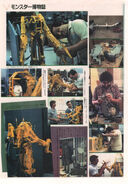Toa Quarax (talk | contribs) No edit summary |
Leigh Burne (talk | contribs) No edit summary |
||
| (13 intermediate revisions by 5 users not shown) | |||
| Line 31: | Line 31: | ||
|counterpart=[[Exosuit]] |
|counterpart=[[Exosuit]] |
||
|era=21st-22nd century |
|era=21st-22nd century |
||
| − | |affiliation=[[United States Colonial Marine Corps|USCM]]<br> Commercial use}}The '''Caterpillar P-5000 Powered Work Loader''',<ref name="CMTM96">{{cite book|title={{ACMTM}}|author=[[Lee Brimmicombe-Wood]]|publisher=[[HarperPrism]]|year=[[1996]]|page=96}}</ref> commonly referred to as a '''Power Loader''', is a commercial mechanized [[exoskeleton]] used for lifting heavy materials and objects. As well as widespread industrial use, the P-5000 is heavily employed by the [[United States Colonial Marine Corps]] to load ordnance on board their starships.<ref name="A2">{{cite video|people=[[James Cameron]] (writer and director)|title='{{A2}}'|medium=DVD|publisher=[[20th Century Fox]]|date=[[1986]]}}</ref> Power Loaders are equipped with hydraulic "claws" |
+ | |affiliation=[[United States Colonial Marine Corps|USCM]]<br> Commercial use}}The '''Caterpillar P-5000 Powered Work Loader''',<ref name="CMTM96">{{cite book|title={{ACMTM}}|author=[[Lee Brimmicombe-Wood]]|publisher=[[HarperPrism]]|year=[[1996]]|page=96}}</ref> commonly referred to as a '''Power Loader''', is a commercial mechanized [[exoskeleton]] used for lifting heavy materials and objects. As well as widespread industrial use, the P-5000 is heavily employed by the [[United States Colonial Marine Corps]] to load ordnance on board their starships.<ref name="A2">{{cite video|people=[[James Cameron]] (writer and director)|title='{{A2}}'|medium=DVD|publisher=[[20th Century Fox]]|date=[[1986]]}}</ref> Power Loaders are equipped with hydraulic "claws" that can be used to hold and manipulate a variety of objects. |
| − | The Colonial Marines (as well as other groups, including the [[Iron Bears]]) also utilized the [[Exosuit]], the military version of the P-5000.<ref>''[[Aliens versus Predator 2]] Prima's Official Strategy Guide''</ref> Perhaps the most famous use of a Power Loader was when [[Ellen Ripley]] used one in desperation to engage a |
+ | The Colonial Marines (as well as other groups, including the [[Iron Bears]]) also utilized the [[Exosuit]], the military version of the P-5000.<ref>''[[Aliens versus Predator 2]] Prima's Official Strategy Guide''</ref> Perhaps the most famous use of a Power Loader was when [[Ellen Ripley]] used one in desperation to engage a {{Xeno}} [[First Acheron Queen|Queen]] in hand-to-hand combat aboard the {{USS|Sulaco}}. |
==History== |
==History== |
||
| Line 39: | Line 39: | ||
==Overview== |
==Overview== |
||
| − | Configured as an anthropomorphic exoskeleton power frame, the P-5000 offers unprecedented flexibility when handling ordnance and cargo during rough field operations. It also serves as a platform for conducting heavy maintenance away from fixed workshops. The Power Loader is able to multiply a human operator's strength and lifting capacity several thousand times<ref name="Alienbook60">{{cite book|title=[[Alien (novel)|Alien novelization]]|author=[[Alan Dean Foster]]|publisher=[[Warner Books, Inc.]]|year=[[1979]]|page=60}}</ref> and is capable of manipulating loads up to 4,000 kg.<ref name="CMTM96"/> The P-5000 a rugged and reliable alternative to conventional forklifts, rigs and cranes. |
+ | Configured as an anthropomorphic exoskeleton power frame, the P-5000 offers unprecedented flexibility when handling ordnance and cargo during rough field operations. It also serves as a platform for conducting heavy maintenance away from fixed workshops. The Power Loader is able to multiply a human operator's strength and lifting capacity several thousand times<ref name="Alienbook60">{{cite book|title=[[Alien (novel)|Alien novelization]]|author=[[Alan Dean Foster]]|publisher=[[Warner Books, Inc.]]|year=[[1979]]|page=60}}</ref> and is capable of manipulating loads up to 4,000 kg.<ref name="CMTM96"/> The P-5000 is a rugged and reliable alternative to conventional forklifts, rigs and cranes. |
The chassis of the P-5000 consists of a reinforced steel framework with two upper load bearing points for the arms. A hydrogen fuel cell is mounted on the back of the frame, providing up to 65 kW of power for the loader.<ref name="CMTM97">{{cite book|title={{ACMTM}}|author=[[Lee Brimmicombe-Wood]]|publisher=[[HarperPrism]]|year=[[1996]]|page=97}}</ref> The articulated legs are attached by two semi-universal bearings on either side of the base of the chassis, allowing up to 60 degrees of 'x' axis (hip swivel) movement; just below these are a set of knee bearings. Leg motions at the hip are controlled by a pair of 20 kW linear motors actuated via a fast-feedback loop slaved to the operator's movements. Below the hip, hydraulic actuators extend from the main load-bearing points to the aft sections of the legs, providing 'z' axis (fore/aft) movement at the knee joints while pitch control is handled by a second series of actuators at the ankles. To prevent toppling while stationary and under load, the chassis is gyrostabilized.<ref name="CMTM97"/> These gyros can be rotated rapidly out of phase in order to 'decouple' the chassis stabilization system along the determined axes of motion and provide the necessary instability required for bipedal movement. For very heavy lifting work, additional stability can be provided by bolting up to 250 kg of concrete ballast to the underside of the chassis.<ref name="CMTM98">{{cite book|title={{ACMTM}}|author=[[Lee Brimmicombe-Wood]]|publisher=[[HarperPrism]]|year=[[1996]]|page=98}}</ref> |
The chassis of the P-5000 consists of a reinforced steel framework with two upper load bearing points for the arms. A hydrogen fuel cell is mounted on the back of the frame, providing up to 65 kW of power for the loader.<ref name="CMTM97">{{cite book|title={{ACMTM}}|author=[[Lee Brimmicombe-Wood]]|publisher=[[HarperPrism]]|year=[[1996]]|page=97}}</ref> The articulated legs are attached by two semi-universal bearings on either side of the base of the chassis, allowing up to 60 degrees of 'x' axis (hip swivel) movement; just below these are a set of knee bearings. Leg motions at the hip are controlled by a pair of 20 kW linear motors actuated via a fast-feedback loop slaved to the operator's movements. Below the hip, hydraulic actuators extend from the main load-bearing points to the aft sections of the legs, providing 'z' axis (fore/aft) movement at the knee joints while pitch control is handled by a second series of actuators at the ankles. To prevent toppling while stationary and under load, the chassis is gyrostabilized.<ref name="CMTM97"/> These gyros can be rotated rapidly out of phase in order to 'decouple' the chassis stabilization system along the determined axes of motion and provide the necessary instability required for bipedal movement. For very heavy lifting work, additional stability can be provided by bolting up to 250 kg of concrete ballast to the underside of the chassis.<ref name="CMTM98">{{cite book|title={{ACMTM}}|author=[[Lee Brimmicombe-Wood]]|publisher=[[HarperPrism]]|year=[[1996]]|page=98}}</ref> |
||
| Line 48: | Line 48: | ||
To work a Power Loader, an operator first backs into the machine, buckling themselves in with the webbing harness. A roll cage is pulled down to provide protection for the head and torso, while feet are secured with straps. Powerup and system diagnostics are handled by a punch keypad built into the operator's handgrips. This keypad also controls any additional external tools fitted to the machine.<ref name="A2"/> |
To work a Power Loader, an operator first backs into the machine, buckling themselves in with the webbing harness. A roll cage is pulled down to provide protection for the head and torso, while feet are secured with straps. Powerup and system diagnostics are handled by a punch keypad built into the operator's handgrips. This keypad also controls any additional external tools fitted to the machine.<ref name="A2"/> |
||
| − | When powered up, the P-5000 is slaved to the operator's limb movements, duplicating their walking and lifting motions almost exactly. Response time to operator input is almost instantaneous, while sophisticated computer controls dampen any system induced 'twitches' or oscillations that arise out of involuntary operator movement.<ref name="CMTM98"/> Problems are only likely to arise if the loader is walking or reaching at full extension, as the system is likely to enhance movement beyond the fine-tuning capabilities of the operator; standard operating procedures typically forbid operators from performing such |
+ | When powered up, the P-5000 is slaved to the operator's limb movements, duplicating their walking and lifting motions almost exactly. Response time to operator input is almost instantaneous, while sophisticated computer controls dampen any system induced 'twitches' or oscillations that arise out of involuntary operator movement.<ref name="CMTM98"/> Problems are only likely to arise if the loader is walking or reaching at full extension, as the system is likely to enhance movement beyond the fine-tuning capabilities of the operator; standard operating procedures typically forbid operators from performing such maneuvers. |
| − | If operating over rough ground, the Power Loader will provide feedback cues to the operator to help them keep his or her footing.<ref name="CMTM98"/> However, owing |
+ | If operating over rough ground, the Power Loader will provide feedback cues to the operator to help them keep his or her footing.<ref name="CMTM98"/> However, owing to the P-5000's high lifting capacity and relatively small foot area, operations with very heavy loads on soft ground are not recommended, as the extreme downward pressure generated underfoot can cause the unit to literally bury itself in the ground.<ref name="CMTM98"/> Automatic lockout systems will generally prevent any movement that will topple the loader, and the system has generally proved safe to use over all but the most treacherous terrain. As with any lifting device, there are strict guidelines regarding weight limits that the loader can handle. |
Though simple in principle, considerable practice is required to use a Power Loader efficiently and safely, and the equivalent of a Class 2 civilian cargo handling license is needed to operate in USCM service.<ref name="CMTM98"/> Operators must become used to the loaders mass and its tendency to 'lead' the operators movements. Operators must be careful not to overcompensate for this tendency, otherwise they may induce unwanted oscillations into the control systems. Operating a P-5000 requires sureness and economy of movement, since hesitancy and exaggerated motion tend to place undue stress on the load-bearing joints. Training to use a Power Loader takes about six weeks of simulator training and 'hands-on' experience, though this is extended to eight weeks to qualify USCM personnel and includes training in rough field operation.<ref name="CMTM98"/> |
Though simple in principle, considerable practice is required to use a Power Loader efficiently and safely, and the equivalent of a Class 2 civilian cargo handling license is needed to operate in USCM service.<ref name="CMTM98"/> Operators must become used to the loaders mass and its tendency to 'lead' the operators movements. Operators must be careful not to overcompensate for this tendency, otherwise they may induce unwanted oscillations into the control systems. Operating a P-5000 requires sureness and economy of movement, since hesitancy and exaggerated motion tend to place undue stress on the load-bearing joints. Training to use a Power Loader takes about six weeks of simulator training and 'hands-on' experience, though this is extended to eight weeks to qualify USCM personnel and includes training in rough field operation.<ref name="CMTM98"/> |
||
| Line 63: | Line 63: | ||
==Trivia== |
==Trivia== |
||
| + | *In the [[Aliens (novel)|novelization]] of {{A2}}, the Power Loader is described as being quadrupedal and elephant-like in design, rather than an anthropomorphic two-legged exosuit.<ref name="Aliensbook84">{{cite book|title=[[Aliens (novel)|Aliens novelization]]|author=[[Alan Dean Foster]]|publisher=Warner Books, Inc.|year=1986|page=84}}</ref> |
||
*A loading vehicle based on the Power Loader appears in the 2010 video game {{AVP2010}}, and features the claws of a Power Loader mounted on a four-wheeled chassis, with a similar space-frame roll cage for the operator. The vehicle is not usable in the game, but appears as scenery in several levels. |
*A loading vehicle based on the Power Loader appears in the 2010 video game {{AVP2010}}, and features the claws of a Power Loader mounted on a four-wheeled chassis, with a similar space-frame roll cage for the operator. The vehicle is not usable in the game, but appears as scenery in several levels. |
||
| + | *In an episode of ''American Dad!'', Francine Smith attacks an synthetic body that Stan was controlling with a suit that resembled a black power loader. |
||
==Gallery== |
==Gallery== |
||
<gallery> |
<gallery> |
||
640px-D7be971bc0b67c4924a8a373360d7.jpg|A Power Loader from ''Aliens: Colonial Marines''. Note the lack of Motion Tracker seen in the final game. |
640px-D7be971bc0b67c4924a8a373360d7.jpg|A Power Loader from ''Aliens: Colonial Marines''. Note the lack of Motion Tracker seen in the final game. |
||
| − | PowerLoaderAVP1.png|A Power Loader (unusable) in {{AVP1999}} |
+ | PowerLoaderAVP1.png|A Power Loader (unusable) in {{AVP1999}}. |
| − | Powerloader.jpg|Ellen Ripley |
+ | Powerloader.jpg|Ellen Ripley prepares for battle against the Queen. |
Aliens-Dec-05.jpg|Christopher Winter battling the Raven in a Power Loader. Also note Bella in the background. |
Aliens-Dec-05.jpg|Christopher Winter battling the Raven in a Power Loader. Also note Bella in the background. |
||
</gallery> |
</gallery> |
||
| Line 76: | Line 78: | ||
<gallery> |
<gallery> |
||
1175594_641597045873632_1724604761_n.jpg|The full size Power Loader from ''Aliens'' on standby during the production of the film.<ref>https://www.facebook.com/photo.php?fbid=641597045873632&set=pb.104664682900207.-2207520000.1382579262.&type=3&theater</ref> |
1175594_641597045873632_1724604761_n.jpg|The full size Power Loader from ''Aliens'' on standby during the production of the film.<ref>https://www.facebook.com/photo.php?fbid=641597045873632&set=pb.104664682900207.-2207520000.1382579262.&type=3&theater</ref> |
||
| − | PowerloaderRarePictures.jpg|Rare |
+ | PowerloaderRarePictures.jpg|Rare insight to the making of a Power Loader. |
</gallery> |
</gallery> |
||
| Line 94: | Line 96: | ||
[[Category:Heavy equipment]] |
[[Category:Heavy equipment]] |
||
[[Category:Ground vehicles]] |
[[Category:Ground vehicles]] |
||
| ⚫ | |||
[[Category:Human vehicles]] |
[[Category:Human vehicles]] |
||
[[Category:Weyland-Yutani]] |
[[Category:Weyland-Yutani]] |
||
| − | [[Category:Weyland Corp]] |
||
[[Category:USCM vehicles]] |
[[Category:USCM vehicles]] |
||
[[Category:USCM Equipment]] |
[[Category:USCM Equipment]] |
||
| ⚫ | |||
| + | [[Category:Aliens (film) equipment]] |
||
Revision as of 14:04, 2 October 2014
- "I can drive that loader. I have a Class-2 rating."
- ―Ripley, lending a hand aboard the USS Sulaco (from Aliens)
The Caterpillar P-5000 Powered Work Loader,[1] commonly referred to as a Power Loader, is a commercial mechanized exoskeleton used for lifting heavy materials and objects. As well as widespread industrial use, the P-5000 is heavily employed by the United States Colonial Marine Corps to load ordnance on board their starships.[2] Power Loaders are equipped with hydraulic "claws" that can be used to hold and manipulate a variety of objects.
The Colonial Marines (as well as other groups, including the Iron Bears) also utilized the Exosuit, the military version of the P-5000.[3] Perhaps the most famous use of a Power Loader was when Ellen Ripley used one in desperation to engage a Xenomorph Queen in hand-to-hand combat aboard the USS Sulaco.
History
The basic Power Loader design was patented by Weyland Corp on January 29, 2025.[4] While initial models were manufactured by Weyland Corp themselves, later commercial versions would be built by Caterpillar Inc.
Overview
Configured as an anthropomorphic exoskeleton power frame, the P-5000 offers unprecedented flexibility when handling ordnance and cargo during rough field operations. It also serves as a platform for conducting heavy maintenance away from fixed workshops. The Power Loader is able to multiply a human operator's strength and lifting capacity several thousand times[5] and is capable of manipulating loads up to 4,000 kg.[1] The P-5000 is a rugged and reliable alternative to conventional forklifts, rigs and cranes.
The chassis of the P-5000 consists of a reinforced steel framework with two upper load bearing points for the arms. A hydrogen fuel cell is mounted on the back of the frame, providing up to 65 kW of power for the loader.[6] The articulated legs are attached by two semi-universal bearings on either side of the base of the chassis, allowing up to 60 degrees of 'x' axis (hip swivel) movement; just below these are a set of knee bearings. Leg motions at the hip are controlled by a pair of 20 kW linear motors actuated via a fast-feedback loop slaved to the operator's movements. Below the hip, hydraulic actuators extend from the main load-bearing points to the aft sections of the legs, providing 'z' axis (fore/aft) movement at the knee joints while pitch control is handled by a second series of actuators at the ankles. To prevent toppling while stationary and under load, the chassis is gyrostabilized.[6] These gyros can be rotated rapidly out of phase in order to 'decouple' the chassis stabilization system along the determined axes of motion and provide the necessary instability required for bipedal movement. For very heavy lifting work, additional stability can be provided by bolting up to 250 kg of concrete ballast to the underside of the chassis.[7]
The loader's arms are attached to the very top of the chassis by a pair of complex universal bearings stressed to operate under loadings of up to 4,000 kg.[7] Arm motions in the 'y' and 'z' axes are controlled by linear motors while movement in the 'x' axis and at the elbows is powered by a series of hydraulic actuators. The limbs mount a set of vice manipulators that are capable of full 360° rotation. Most common industrial storage mediums are fitted with uniform, purpose-made grips than can easily interface with the P-5000's claws. Typically, one fork of each vice is placed under the object to be lifted while the other fork clamps down on top of the object, holding it firmly and securely.[2] Manipulator function is controlled from an operator handgrip/joystick combination situated on the inside of each limb. Attachment points for additional tools (such as cutters and welders) are located on the manipulators.[7]
Operation
To work a Power Loader, an operator first backs into the machine, buckling themselves in with the webbing harness. A roll cage is pulled down to provide protection for the head and torso, while feet are secured with straps. Powerup and system diagnostics are handled by a punch keypad built into the operator's handgrips. This keypad also controls any additional external tools fitted to the machine.[2]
When powered up, the P-5000 is slaved to the operator's limb movements, duplicating their walking and lifting motions almost exactly. Response time to operator input is almost instantaneous, while sophisticated computer controls dampen any system induced 'twitches' or oscillations that arise out of involuntary operator movement.[7] Problems are only likely to arise if the loader is walking or reaching at full extension, as the system is likely to enhance movement beyond the fine-tuning capabilities of the operator; standard operating procedures typically forbid operators from performing such maneuvers.
If operating over rough ground, the Power Loader will provide feedback cues to the operator to help them keep his or her footing.[7] However, owing to the P-5000's high lifting capacity and relatively small foot area, operations with very heavy loads on soft ground are not recommended, as the extreme downward pressure generated underfoot can cause the unit to literally bury itself in the ground.[7] Automatic lockout systems will generally prevent any movement that will topple the loader, and the system has generally proved safe to use over all but the most treacherous terrain. As with any lifting device, there are strict guidelines regarding weight limits that the loader can handle.
Though simple in principle, considerable practice is required to use a Power Loader efficiently and safely, and the equivalent of a Class 2 civilian cargo handling license is needed to operate in USCM service.[7] Operators must become used to the loaders mass and its tendency to 'lead' the operators movements. Operators must be careful not to overcompensate for this tendency, otherwise they may induce unwanted oscillations into the control systems. Operating a P-5000 requires sureness and economy of movement, since hesitancy and exaggerated motion tend to place undue stress on the load-bearing joints. Training to use a Power Loader takes about six weeks of simulator training and 'hands-on' experience, though this is extended to eight weeks to qualify USCM personnel and includes training in rough field operation.[7]
Weyland Corp Description
"Since introduction, the power loader has improved workplace safety by 300% in off-world applications. Its low alloy steel exoskeleton is designed to withstand maximum compression stress, keeping the driver safe from external blows. Hydraulically stabilized legs give 3 tons of load lifting ability."[8]
Behind the Scenes
The Power Loader in Aliens was a full-scale prop constructed around stuntman John Lees, who was concealed inside, immediately behind Sigourney Weaver.[9] The suit featured electrically-operated claws, although the various hydraulic systems were cosmetic only. The tandem design allowed Sigourney Weaver to be in the operator's seat at all times, while Lees controlled the suit from within. Owing to it's weight and bulk, the suit was either suspended from wires (concealed within the radio antennae on the suit's shoulders) or mounted on a counterbalanced crane.[9] Additionally, a scale miniature was used for some shots, including wide shots during the fight with the Queen and the scene where the suit is ejected into space, for which the camera was hung vertically and the suit was dropped away onto a safety net painted to resemble space.[9]
A new weaponized version of the Power Loader was set to appear in Aliens: Colonial Marines and was featured in the E3 demonstration of the game; it was essentially a standard P-5000 outfitted with an M56 Smartgun fitted to one arm and an M240 Incinerator Unit on the other. However, it was cut from the final product. Although not specified, it seems likely this exoskeleton was not supposed to be purpose-built military equipment, but merely an ad hoc combat exosuit constructed by the Marines from existing commercial equipment and their own weaponry. While the weaponized version was cut, the standard Power Loader did appear in the final game, and was fitted with a M314 Motion Tracker attached to the roll cage with what appears to just be zip ties.
Trivia
- In the novelization of Aliens, the Power Loader is described as being quadrupedal and elephant-like in design, rather than an anthropomorphic two-legged exosuit.[10]
- A loading vehicle based on the Power Loader appears in the 2010 video game Aliens vs. Predator, and features the claws of a Power Loader mounted on a four-wheeled chassis, with a similar space-frame roll cage for the operator. The vehicle is not usable in the game, but appears as scenery in several levels.
- In an episode of American Dad!, Francine Smith attacks an synthetic body that Stan was controlling with a suit that resembled a black power loader.
Gallery
Behind the scenes
Appearances
- Aliens/novel (First Appearance)
- Aliens: Newt's Tale
- Aliens versus Predator
- Aliens: Extermination
- Aliens: Infestation
- Aliens: Colonial Marines (video game)
External Links
References
- ↑ 1.0 1.1 Lee Brimmicombe-Wood. 'Aliens: Colonial Marines Technical Manual', p. 96 (1996), HarperPrism.
- ↑ 2.0 2.1 2.2 James Cameron (writer and director). Aliens (1986), 20th Century Fox [DVD].
- ↑ Aliens versus Predator 2 Prima's Official Strategy Guide
- ↑ "Weyland Industries - Corporate Timeline". Retrieved on 2013-06-07.
- ↑ Alan Dean Foster. Alien novelization, p. 60 (1979), Warner Books, Inc..
- ↑ 6.0 6.1 Lee Brimmicombe-Wood. 'Aliens: Colonial Marines Technical Manual', p. 97 (1996), HarperPrism.
- ↑ 7.0 7.1 7.2 7.3 7.4 7.5 7.6 7.7 Lee Brimmicombe-Wood. 'Aliens: Colonial Marines Technical Manual', p. 98 (1996), HarperPrism.
- ↑ "Weyland Industries - Security". Retrieved on 2013-09-16.
- ↑ 9.0 9.1 9.2 James Cameron, Gale Anne Hurd, Gordon Carroll, David Giler, Walter Hill, Stan Winston. Superior Firepower: The Making of 'Aliens' (2003), 20th Century Fox [DVD].
- ↑ Alan Dean Foster. Aliens novelization, p. 84 (1986), Warner Books, Inc..
- ↑ https://www.facebook.com/photo.php?fbid=641597045873632&set=pb.104664682900207.-2207520000.1382579262.&type=3&theater

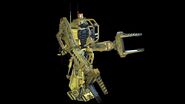
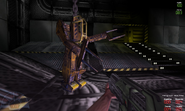
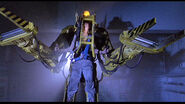
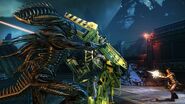
![1175594 641597045873632 1724604761 n.jpg (81 KB) The full size Power Loader from Aliens on standby during the production of the film.[11]](https://static.wikia.nocookie.net/avp/images/e/e5/1175594_641597045873632_1724604761_n.jpg/revision/latest/scale-to-width-down/155?cb=20131024014908)
